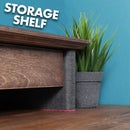Introduction: Make a Mini Side Table With Built in Power!
I always have a collection of cables and chargers that gather on the floor around power sockets. I also end up with my TV remotes on the floor too so I thought it was time to come up with a solution.
Here is the full project video:
Materials Used:
- 18mm Plywood
- Pattress Box
- Double Socket w/ USB Ports
- Black Felt
- Black Paint
- Spray Lacquer
- Milliput Epoxy Putty
- Screws
- Wood Glue
- Spray Adhesive
- Self Adhesive Paper
Tools Used:
- Jigsaw
- Drill & Driver
- Scissors
Step 1: Create the Box
The project begins with some 18mm plywood. I've included a cut list if you want to use my dimensions. These pieces will form a shallow box.
Before we put the box together we need to turn our attention to the top the power socket will be housed in a pattress box so with it centred 30mm away from the top edge I trace round it. I also create some layout marks for where my remotes can be stored.
These areas will be cut out with the jigsaw so drilling some holes makes it easy to thread the blade though
Take it slow and steady with the jigsaw. Its always best to leave the line you drew because can always remove more material if needed. Its much harder to put it back.
With both areas cut out sanding with 80 grit sand paper smooths out the cuts and removes any sharp egdes
The construction of the box is very basic. At this stage its just a case of getting all the pece in place flush then drilling pilot holes through the top into the sides and securing with screws the same for the bottom too
with the box together the hole in the middle of the pattress box can be drilled through this is where the power cable will fed through later
some smaller screw secure the pattress box down too
The top of the box can be permanantly fixed in place so I removed it, added a bead of wood glue around the edge and then reattached the top with the screws. The bottom needs to be removable so that stays as is with no glue
the screws on top get covered with wood filler. These will become near invisible when its painted.
Step 2: Create the Legs, Paint & Add Felt
I thought some nice curved legs would look great so I printed off a template onto some self adhesive paper and then cut them out using the jigsaw.
Drillin the holes through for screws makes the alignment much easier.
Tracing round the legs in place and adding painters tape will maintain bare wood after painting this will allow wood glue to adhere properly later.
I gave all the pieces 3 coats of black paint. I only painted the inside of the legs though I thought the plywood outer surface would be a nice contrast.
The legs got 3 coats of lacquer on the outside face and edges before I drilled countersink holes for the screws.
Removing the painters tape reveals the bare wood, now glue can be applied on the sides and the legs can be permanently attached. The countersunk holes get filled with black epoxy putty. It can be made flush later.
At the moment the remote storage is just a hole so I used spray adhesive to add felt to some plywood. It gets trimmed to size with scissors and then secured in place with screws.
The pattress box sits flush with the surface so to help obscure it, I coloured the top edges black with permanent marker. It can then be secured in place.
Step 3: Wiring
Now for the wiring.
I had a black extension lead I could take the wire and plug from for this job. Using scissors to carefully cut through the outer shielding I could slide it off and expose the live, neutral and earth wires inside. The socket I have is very well labeled but always make sure you follow the wiring guide yours comes with.
The sleeving on the smaller wires also needs to be removed so I carefully cut through the sleeve making sure not to damage the wire inside. This gave me about 6mm of exposed wire. Twisting the wire helps keep it neat and will give a better connection in the socket.
I could then install the wires in the socket. Brown to live, Blue to neutral and yellow green to earth. These are the standard colour arrangement but always follow the wiring instructions for your socket.
The socket I have has concealed screws so the front panel pops off to reveal them.
Before securing the socket to the pattress box I make sure to run the cable through the hold down at the side of the pattress box. This will prevent the wires from getting pulled out.
Now the socket can be screwed into place and the front panel popped back on. After I plug in the power I can test it out.
the USB ports will save me needing a separate charger all the time. The 2 power ports work great too.
Step 4: Finish Legs & Done!
All that's left to do on this one is pare off the black epoxy and sand it flush.
A quick spray of lacquer finishes them off nicely.
I really hope you liked this project! I went with a small side table that could fit under my bed for this design but the idea of adding remote storage and a power socket could be applied to any design really. Even existing furniture could be adapted to include these additions.

Participated in the
Trash to Treasure

Participated in the
Pro Tips Challenge













